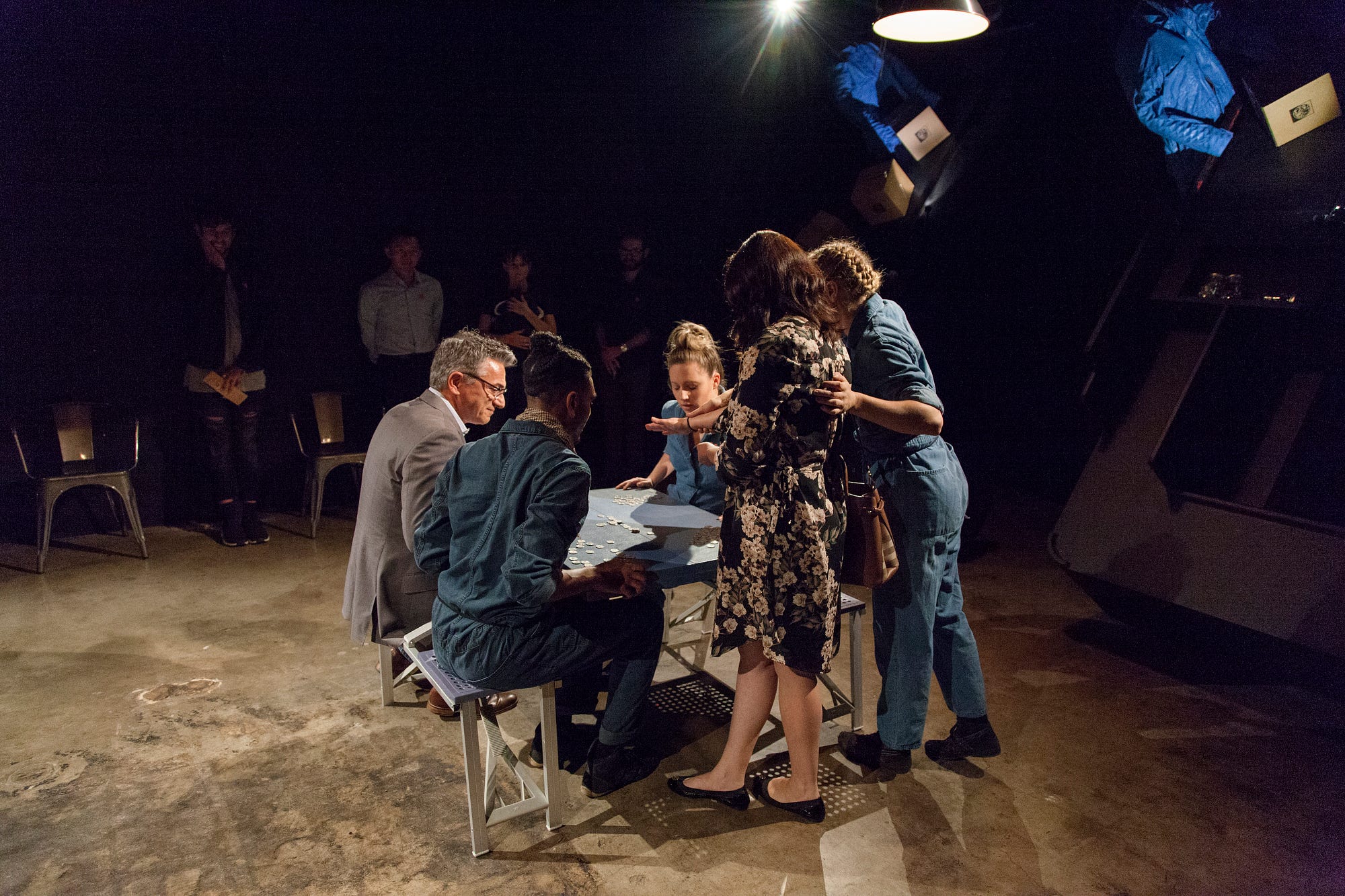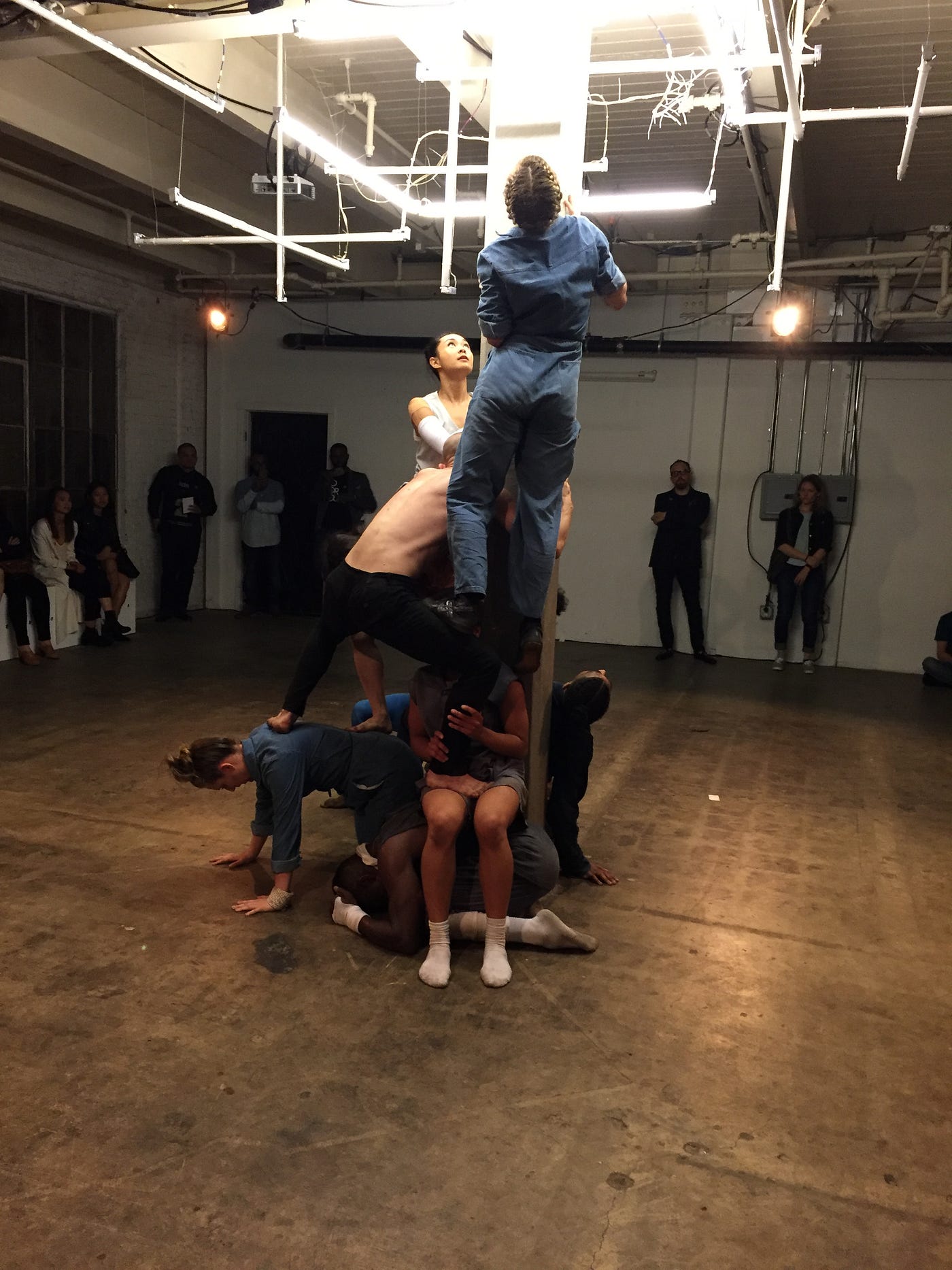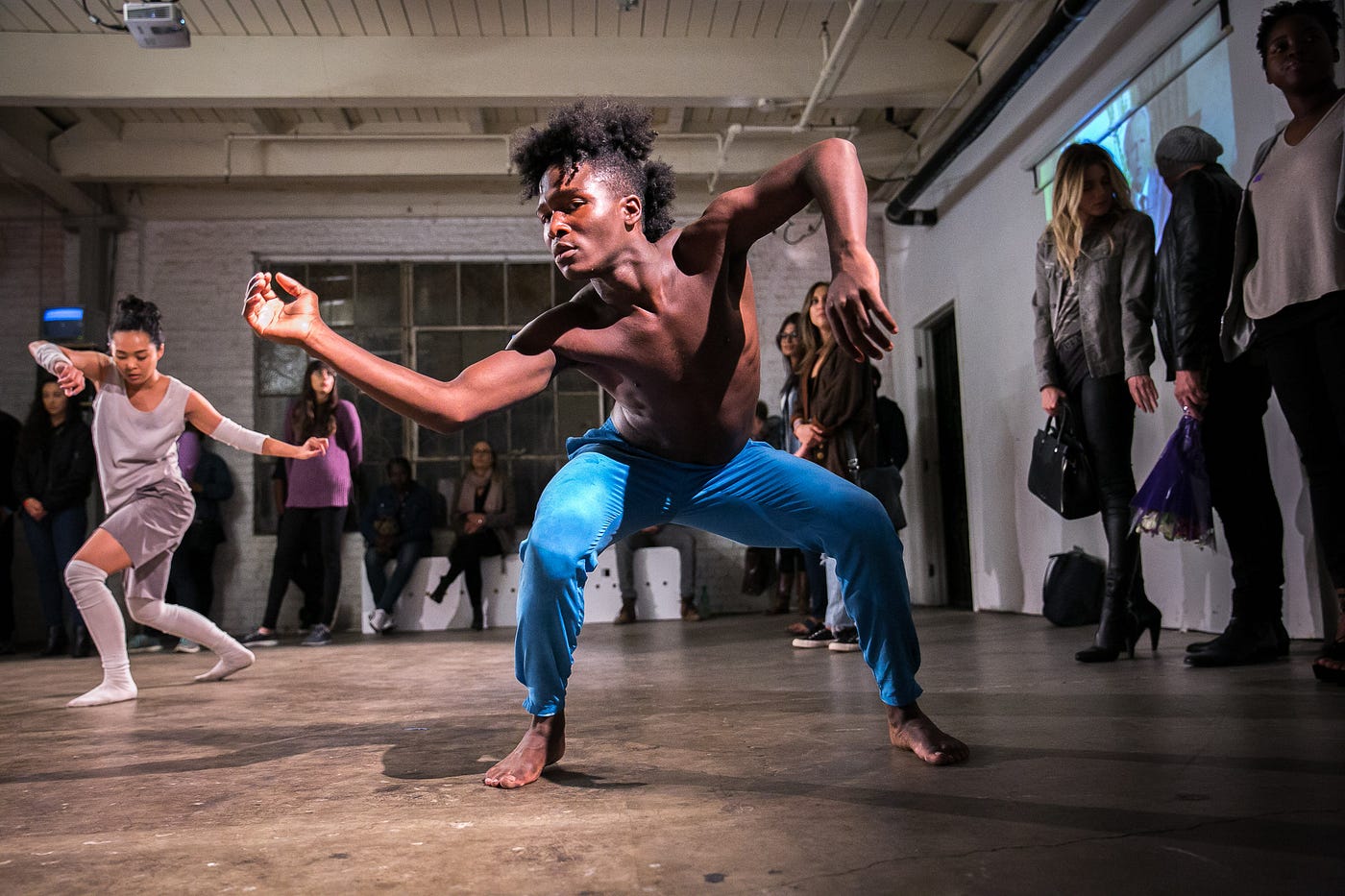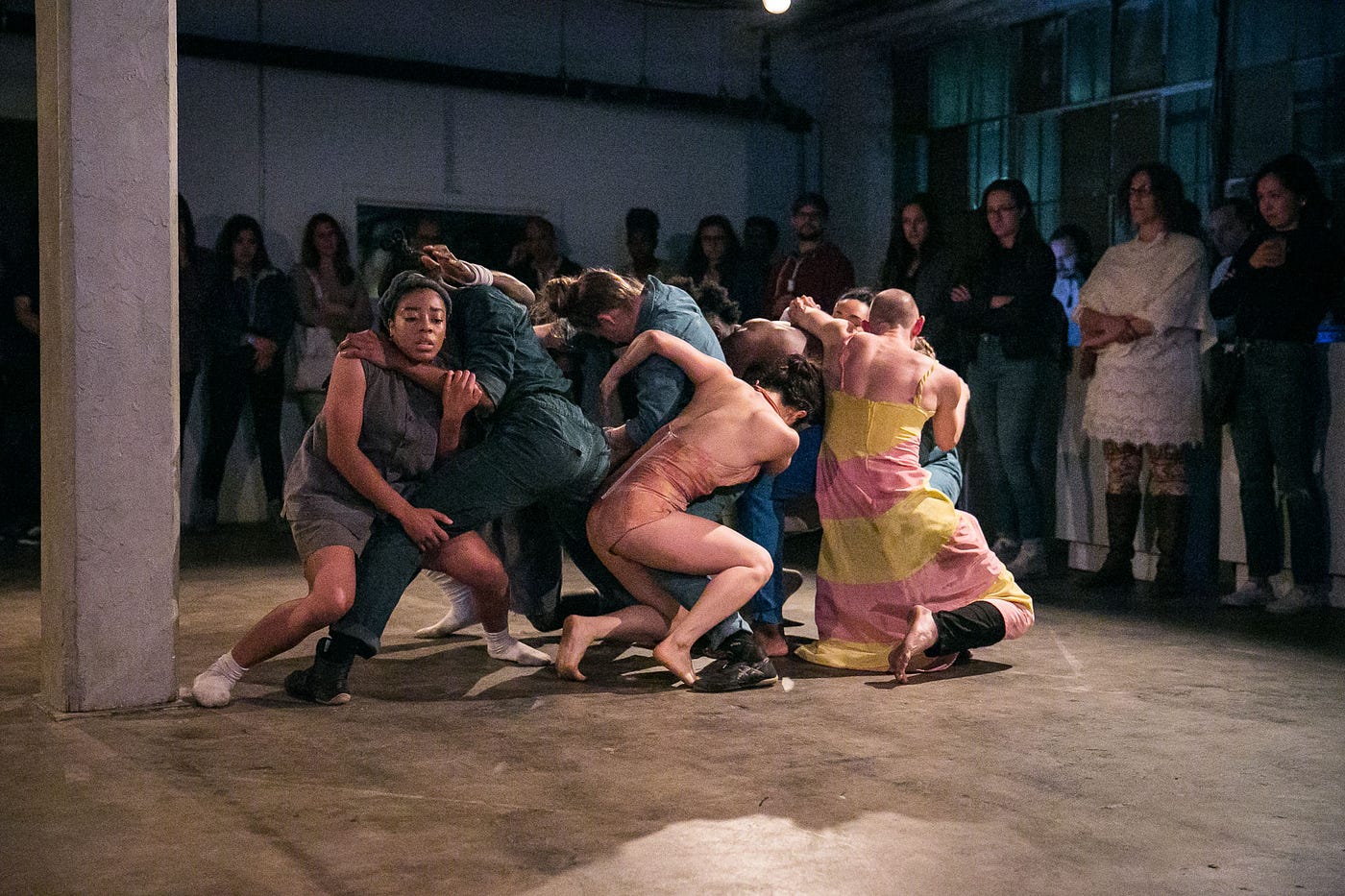
I can’t recall the last time I was turned into a tree.
It certainly hasn’t happened in any of the plays I’ve been to of late. Nor any of the not-quite-definable experiments that populate the whole of the “Big I” immersive world.
Yet there I was on a Friday night in South Los Angeles, quite off the beaten path of the Art District pop-ups, Westside apartment one-on-ones, and Eastside explorations of the American canon. Standing inside the main room of a studio space that has been transformed into the venue for The Other Side — the debut immersive dance-theatre from Iris Company — with a dancer delicately placing grapes at various points on my person.
In and on my hands, the crook of my elbow, the point where my neck meets my shoulder, and the top of my head. Grapes so fat and oblong that at first I thought they were olives. Until I bit into one.
What?
If someone puts fruit all over you, you’re allowed to eat it.
The dancer performing this little ritual was one of the three assigned to the role of “factory worker” in this piece. Or at least that’s how I came to define them. Creator Sophia Stoller has devised with her exceptionally talented collaborators a world that translates the infamous psychological role-playing of the Stanford Prison and Milgram experiments into a piece of contemporary dance theatre with a moving political message.

That this is a piece of immersive dance theatre makes for a double challenge. Dance theatre in and of itself can be opaque to those who are not initiated in viewing the form, which melds narrative with the abstract, poetic movements of the performers. Immersive staging also asks a lot out of an uninitiated audience, who may not have the sense of awareness to get out of the way of a fast moving performer.
Get Noah J Nelson’s stories in your inbox
Join Medium for free to get updates from this writer.
SubscribeSubscribe
Putting the two together can be electric, and Stoller’s raw and powerful choreography taps into a live wire. At the layer of the dancing, it is hard to believe that this is Iris Company’s first work. The ensemble of dancers doesn’t feel like a freshly minted group. That’s not something you get to see all the time. I had the luxury of watching the first open rehearsal of The Other Side, and it was clear at that point that the dance — propelled by Justin Scheid’s incredible original score — was itself something special.
To that essential ingredient wedded two major additions: the video work of Peter Amodeo Gould and Keith Skretch and an interactive frame by director Jamie Peterson.
The video work brings two essential beats to the storytelling — setting up the world of the fictional CCC Institute that is conducting the experiments — and a late in the game moment that I won’t spoil out of respect for the work. It is not all that the video work in the piece does, but the initial framing of the CCC founder by Gould sets a definitive tone for the work that follows: a tightrope balance of the arch and sinister.
Peterson, whose masterful At An Appointed Time was one of the early darlings of the LA immersive renaissance way back in 2014, took on the challenge of building a layer of actor-interaction with the audience in the form of “Research Executors” who act as ushers and guides into the world of the show.
We first meet the Executors in the main room, the lobby if you will, of the CCC Institute. After a quick orientation — including the video of the founder — the audience is divided into three groups. Each is led into an environment where a trio of dancers have been assigned to a role in this miniaturized society.

There are three distinct classes: one that represents impoverished field laborers, one consisting of the aforementioned “factory workers”, and another that represents a particularly feckless group of One Percenters. All three are wrapped up in an economy that revolves around boxes, coins, and grapes: with the power vested fully in the hands of the endlessly partying, selfie-obsessed, One Percent.
After an initial round of action that keeps the audience more or less locked in with their assigned group The Other Side opens up into a looped structure. The action repeats, giving the audience the freedom to roam about the sandbox and uncover the connections between the three disparate groups. There aren’t a lot of immersives that use a looping structure on the West Coast, and that’s a shame. There’s a lot of value in giving the audience the agency to fully explore a piece’s action as they will.

The movement layer of The Other Side is nothing short of breathtaking for a dance theatre fan such as yours truly. It is well worth the time and effort to seek out this show for that part of the dish. My expectations for what the “Research Executors” were up to, however, were not met on opening night. The idea that there should be a layer of performance that acts as a bridge between the fiction of the CCC Institute’s lore and the abstract physicality of the dancers is a good one. To stretch a food metaphor out for a moment: things are well plated, but as the work develops I’d like to see the flavors blend together in order to give the work more depth. It was too easy to loose track of what the Executors were up to, as they occupied a reality that was neither quite that of the dance, nor the audience.
The good news is that even with the different strata not completely melding they are all still telling the same story, just in different ways. I know that Iris Company is looking at this run of The Other Side not as a one-off, but as an opening salvo in the development of the piece. What might come about once it is all given a chance to come to a simmer?
The better news is that none of these notes detract in my heart from the punch that The Other Side has. This is a piece that I didn’t know I needed until I saw it, and Stoller’s creation works as a kind of empathic catharsis in these very rough times.
The Other Side wraps up its debut run May 12th and 13th at Gramercy Studios 2010 W 62nd St, Los Angeles, CA 90047. Tickets are $30 for students, $40 general admission.




















Discussion